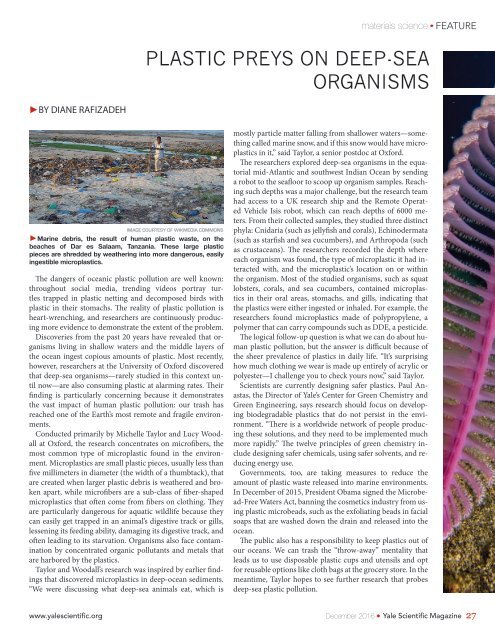YSM Issue 90.1
Create successful ePaper yourself
Turn your PDF publications into a flip-book with our unique Google optimized e-Paper software.
materials science<br />
FEATURE<br />
PLASTIC PREYS ON DEEP-SEA<br />
ORGANISMS<br />
►BY DIANE RAFIZADEH<br />
IMAGE COURTESY OF WIKMEDIA COMMONS<br />
►Marine debris, the result of human plastic waste, on the<br />
beaches of Dar es Salaam, Tanzania. These large plastic<br />
pieces are shredded by weathering into more dangerous, easily<br />
ingestible microplastics.<br />
The dangers of oceanic plastic pollution are well known:<br />
throughout social media, trending videos portray turtles<br />
trapped in plastic netting and decomposed birds with<br />
plastic in their stomachs. The reality of plastic pollution is<br />
heart-wrenching, and researchers are continuously producing<br />
more evidence to demonstrate the extent of the problem.<br />
Discoveries from the past 20 years have revealed that organisms<br />
living in shallow waters and the middle layers of<br />
the ocean ingest copious amounts of plastic. Most recently,<br />
however, researchers at the University of Oxford discovered<br />
that deep-sea organisms—rarely studied in this context until<br />
now—are also consuming plastic at alarming rates. Their<br />
finding is particularly concerning because it demonstrates<br />
the vast impact of human plastic pollution: our trash has<br />
reached one of the Earth’s most remote and fragile environments.<br />
Conducted primarily by Michelle Taylor and Lucy Woodall<br />
at Oxford, the research concentrates on microfibers, the<br />
most common type of microplastic found in the environment.<br />
Microplastics are small plastic pieces, usually less than<br />
five millimeters in diameter (the width of a thumbtack), that<br />
are created when larger plastic debris is weathered and broken<br />
apart, while microfibers are a sub-class of fiber-shaped<br />
microplastics that often come from fibers on clothing. They<br />
are particularly dangerous for aquatic wildlife because they<br />
can easily get trapped in an animal’s digestive track or gills,<br />
lessening its feeding ability, damaging its digestive track, and<br />
often leading to its starvation. Organisms also face contamination<br />
by concentrated organic pollutants and metals that<br />
are harbored by the plastics.<br />
Taylor and Woodall’s research was inspired by earlier findings<br />
that discovered microplastics in deep-ocean sediments.<br />
“We were discussing what deep-sea animals eat, which is<br />
mostly particle matter falling from shallower waters—something<br />
called marine snow, and if this snow would have microplastics<br />
in it,” said Taylor, a senior postdoc at Oxford.<br />
The researchers explored deep-sea organisms in the equatorial<br />
mid-Atlantic and southwest Indian Ocean by sending<br />
a robot to the seafloor to scoop up organism samples. Reaching<br />
such depths was a major challenge, but the research team<br />
had access to a UK research ship and the Remote Operated<br />
Vehicle Isis robot, which can reach depths of 6000 meters.<br />
From their collected samples, they studied three distinct<br />
phyla: Cnidaria (such as jellyfish and corals), Echinodermata<br />
(such as starfish and sea cucumbers), and Arthropoda (such<br />
as crustaceans). The researchers recorded the depth where<br />
each organism was found, the type of microplastic it had interacted<br />
with, and the microplastic’s location on or within<br />
the organism. Most of the studied organisms, such as squat<br />
lobsters, corals, and sea cucumbers, contained microplastics<br />
in their oral areas, stomachs, and gills, indicating that<br />
the plastics were either ingested or inhaled. For example, the<br />
researchers found microplastics made of polypropylene, a<br />
polymer that can carry compounds such as DDE, a pesticide.<br />
The logical follow-up question is what we can do about human<br />
plastic pollution, but the answer is difficult because of<br />
the sheer prevalence of plastics in daily life. “It’s surprising<br />
how much clothing we wear is made up entirely of acrylic or<br />
polyester—I challenge you to check yours now,” said Taylor.<br />
Scientists are currently designing safer plastics. Paul Anastas,<br />
the Director of Yale’s Center for Green Chemistry and<br />
Green Engineering, says research should focus on developing<br />
biodegradable plastics that do not persist in the environment.<br />
“There is a worldwide network of people producing<br />
these solutions, and they need to be implemented much<br />
more rapidly.” The twelve principles of green chemistry include<br />
designing safer chemicals, using safer solvents, and reducing<br />
energy use.<br />
Governments, too, are taking measures to reduce the<br />
amount of plastic waste released into marine environments.<br />
In December of 2015, President Obama signed the Microbead-Free<br />
Waters Act, banning the cosmetics industry from using<br />
plastic microbeads, such as the exfoliating beads in facial<br />
soaps that are washed down the drain and released into the<br />
ocean.<br />
The public also has a responsibility to keep plastics out of<br />
our oceans. We can trash the “throw-away” mentality that<br />
leads us to use disposable plastic cups and utensils and opt<br />
for reusable options like cloth bags at the grocery store. In the<br />
meantime, Taylor hopes to see further research that probes<br />
deep-sea plastic pollution.<br />
www.yalescientific.org<br />
December 2016<br />
Yale Scientific Magazine<br />
27


















